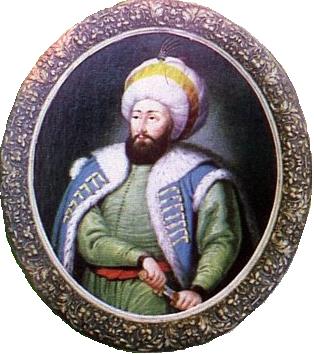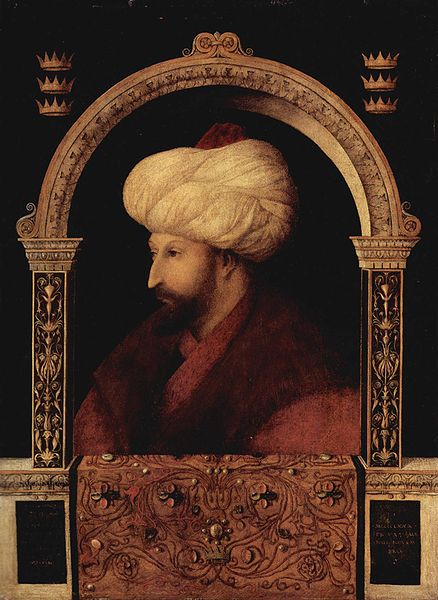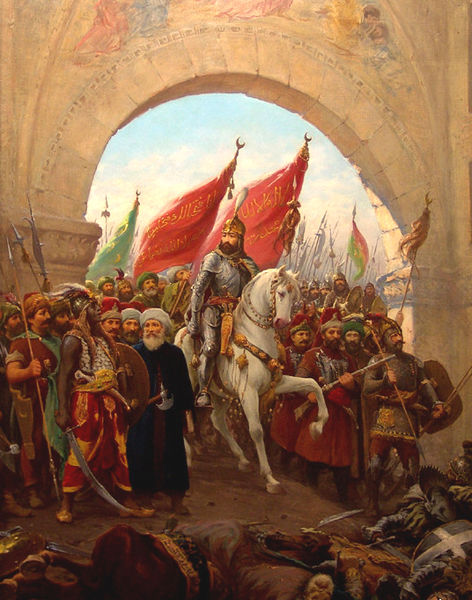<Back to Index>
- Logician Stanisław Leśniewski, 1886
- Painter Francisco José de Goya y Lucientes, 1746
- Sultan of the Ottoman Empire Mehmet II, 1432



Mehmet II (Ottoman Turkish: محمد الثانى Meḥmed-i s̠ānī, Turkish: II. Mehmet),(also known as el-Fātiḥ (الفاتح), "the Conqueror", in Ottoman Turkish, or, in modern Turkish, Fatih Sultan Mehmet; Known as Mahomet II[1][2] in early modern Europe) (March 30, 1432,Edirne – May 3, 1481, Hünkârçayırı, near Gebze) was Sultan of the Ottoman Empire (Rûmuntil the conquest) for a short time from 1444 to September 1446, and later from February 1451 to 1481. At the age of 21, he conquered Constantinople, bringing an end to theByzantine Empire. Mehmet continued his conquests in Asia, with the Anatolian reunification, and in Europe, as far as Belgrade. Administrative actions of note include the amalgamation the old Byzantine administration into the Ottoman state. It is notable that Mehmet II is not considered the first Turkic origin ruler of Constantinople. Before him, the Christian Leo IV the Khazar was a de jure Roman Emperor. Beside Turkish, he spokeFrench, Latin, Greek, Serbian, Persian, Arabic and Hebrew.[3][4]
He had several wives: Valide Sultan Amina Gul-Bahar , an Orthodox Greek woman[5] of noble birth from the village of Douvera, Trabzon,[5] who died in 1492, the mother of Bayezid II, and Gevher Sultana; Gulshah Hatun; Sitti Mukrime Hatun[6]; Hatun Çiçek; Helene Hatun, who died in 1481, daughter of Demetrios II Palaiologos, the Despot of Morea; briefly Anna Hatun, the daughter of the Emperor of Trebizond; and Hatun Alexias, a Byzantine princess. Another son of his was Djem Zizim, who died in 1495.
Mehmed II was born in Edirne, the then-capital city of the Ottoman state, on March 30, 1432. His father was Sultan Murad II (1404–51) and his mother Valide Sultan Hüma Hatun, born in Devrekani county of Kastamonu province, was a daughter of Abd'Allah of Hum(Huma meaning a girl/woman from Hum). When Mehmed II was 11 years old he was sent to Amasya to govern and thus gain experience, as per the custom of Ottoman rulers before his time. After Murad II made peace with the Karaman Emirate in Anatolia in August 1444, he abdicated the throne to his 12-year-old son Mehmed II.
During his first reign, Mehmed II asked his father Murad II to reclaim the throne in anticipation of the Battle of Varna, but Murad II refused. Enraged at his father, who had long since retired to a contemplative life in southwestern Anatolia, Mehmed II wrote: "If you are the Sultan, come and lead your armies. If I am the Sultan I hereby order you to come and lead my armies." It was upon this letter that Murad II led the Ottoman army in the Battle of Varna in 1444.
It is said Murad II's return to the throne was forced by Chandarli Khalil Pasha, the grand vizier at the time, who was not fond of Mehmed II's rule, since Mehmed II's teacher was influential on him and did not like Chandarli. Chandarli was later executed by Mehmed II during the siege of Constantinople on the grounds that he had been bribed by or had somehow helped the defenders.
He married Valide Sultan Amina Gul-Bahar, of Greek descent[5] of noble birth from the village of Douvera, Trabzon,[5] who died in 1492. She was the mother of Bayezid II. When
Mehmed II ascended the throne in 1451 he devoted himself to
strengthening the Ottoman navy, and in the same year made preparations
for the taking of Constantinople. In the narrow Bosporus Straits, the fortress Anadoluhisarı had been built by his great-grandfather Bayezid I on the Asiatic side; Mehmed erected an even stronger fortress called Rumelihisarı on
the European side, and thus having complete control of the strait.
Having completed his fortresses, Mehmet proceeded to levy a toll on
ships passing within reach of their cannon. A Venetian vessel refusing
signals to stop, was sunk with a single shot.[7] In
1453 Mehmed commenced the siege of Constantinople with an army between
80,000 to 200,000 troops and a navy of 320 vessels, though the bulk of
them were transports and storeships. The city was now surrounded by sea
and land; the fleet at the entrance of the Bosphorus was stretched from
shore to shore in the form of a crescent, to intercept or repel any
assistance from the sea for the besieged.[7] It is said that when Mehmed stepped into the ruins of the Boukoleon, known to the Ottomans and Persians as the Palace of the Caesars, probably built over a thousand years before by Theodosius II, he uttered the famous lines of Persian poetry: After the Fall of Constantinople, Mehmed claimed the title of "Caesar" of Rome (Kayser-i Rûm), although this claim was not recognized by the Patriarch of Constantinople, or Christian Europe. Mehmed's claim rested with the concept that Constantinople was the seat of the Roman Empire, after the transfer of its capital to Constantinople in 330 AD and the fall of the Western Roman Empire. Mehmed also had a blood lineage to the Byzantine Imperial family, as his predecessors like Sultan Orhan I had married a Byzantine princess. He was not the only ruler to claim such a title, as there was the Holy Roman Empire in Western Europe, whose emperor, Frederick III, traced his titular lineage from Charlemagne who obtained the title of Roman Emperor when he was crowned by Pope Leo III in 800 - although never recognized as such by the Byzantine Empire. Steven Runciman recounts a story by the Byzantine historian Doukas, known for his colorful and dramatic descriptions,[8] in which Mehmed II, upon the conquest of Constantinople, was said to have ordered the 14-year old son of the Grand Duke Lucas Notaras brought
to him for his personal pleasure. When the father refused to deliver
his son to such a fate he had them both decapitated on the spot.[9] Another contemporary Greek source, Leonard of Chios, professor of theology and Archbishop of Mytilene, tells the same story in his letter to Pope Nicholas. He describes Mehmed II requesting for the 14 year old handsome youth to be brought "for his pleasure" [10]. Reference is made to the prospective conquest of Constantinople in an authentic hadith, attributed to a saying of the ProphetMuhammad. "Verily you shall conquer Constantinople. What a wonderful leader will he be, and what a wonderful army will that army be!"[11] Ten years after the conquest of Constantinople Mehmed II visited the site of Troy and boasted that he had avenged the Trojansby having conquered the Greeks (Byzantines)[12]. The conquest of Constantinople allowed Mehmed II to turn his attention to Anatolia. Mehmed II tried to create a single political entity inAnatolia by capturing Turkish states called Beyliks and the Greek Empire of Trebizond in northeastern Anatolia and allied himself with the Golden Horde in the Crimea. Uniting the Anatolian Beyliks was first accomplished by Sultan Bayezid I, more than fifty years earlier than Mehmed II but after the destructive Battle of Ankara back
in 1402, the newly formed Anatolian unification was gone. Mehmed II
recovered the Ottoman power on other Turkish states. These conquests
allowed him to push further into Europe. Another important political entity which shaped the Eastern policy of Mehmed II was the White Sheep Turcomans. With the leadership of Uzun Hasan,
this Turcoman kingdom gained power in the East but because of their
strong relations with the Christian powers like Empire of Trebizond and
the Republic of Venice and the alliance between Turcomans and Karamanoğlu Tribe,
Mehmed saw them as a threat to his own power. He led a successful
campaign against Uzun Hasan in 1473 which resulted with the decisive
victory of the Ottoman Empire in the Battle of Otlukbeli. After the Fall of Constantinople, Mehmed would also go on to conquer the Despotate of Morea in the Peloponnese in 1460, and theEmpire of Trebizond in northeastern Anatolia in
1461. The last two vestiges of Byzantine rule were thus absorbed by the
Ottoman Empire. The conquest of Constantinople bestowed immense glory
and prestige on the country. Mehmed II advanced toward Eastern Europe as far as Belgrade, and attempted to conquer the city from John Hunyadi at the Siege of Belgrade in
1456. Hungarian commanders successfully defended the city and Ottomans
retreated with heavy losses but at the end, Ottomans occupied nearly
all of Serbia. In
1463, after a dispute over the tribute paid annually by the Bosnian
kingdom, Mehmed invaded Bosnia and conquered it very quickly, executing
the last Bosnian king Stjepan Tomašević. He also came into conflict with and was defeated by Prince Vlad III Dracula of Wallachia in 1462 at the Night Attack. Then, Mehmed II helped Radu,
the brother of Vlad, to take the revenge of the Ottoman military losses
and Radu managed to take the control of Wallachia in the same year.
Vlad lost all his power and escaped from his country. In 1475, the Ottomans suffered a great defeat at the hands of Stephen the Great of Moldavia at the Battle of Vaslui. In 1476, Mehmed won a victory against Stephen at the Battle of Valea Albă and nearly destroyed all of the relatively small Moldovian army. Then, he sacked the capital of Suceava, but could not take the castle of Târgu Neamţ,
nor the citadel of Suceava. With a plague running in his camp and food
and water being very scarce, Mehmed was forced to retreat as Stephen
was reinforcing his army and Dracula, turning from exile, was marching
with a 30,000-strong army to aid the Moldavians. Mehmed II invaded Italy in 1480. The intent of his invasion was to capture Rome and "reunite the Roman Empire", and, at first, looked like he might be able to do it with the easy capture of Otranto in 1480 but Otranto was retaken by Papal forces in 1481 after the death of Mehmed. The Albanian resistance in Albania between 1443 and 1468 led by George Kastrioti Skanderbeg (İskender Bey), an Albanian noble and a former member of the Ottoman ruling elite, prevented the Ottoman expansion into the Italian peninsula. Skanderbeg had united theAlbanian Principalities in a fight against the Empire in the League of Lezhë in 1444. These
military conflicts between the Ottomans and the European forces showed
that the Ottoman presence in Europe was not a temporary situation.
During the reign of Mehmed II, the Balkan forces were not completely
surpassed by the Ottoman war machine, but could not stop it either. Mehmed
II amalgamated the old Byzantine administration into the Ottoman state.
He first introduced the word Politics into Arabic "Siyasah" from a book
he published and claimed to be the collection of Politics doctrines of
the Byzantine Caesars before him. He gathered Italian artists, humanists and Greek scholars at his court, kept the Byzantine Church functioning, ordered the patriarch to translate the Christian faith into Turkish and called Gentile Bellini from
Venice to paint his portrait. He was extremely serious about his
efforts to continue the Roman Empire, with him as its Caesar, and came
closer than most people realize to capturing Rome and conquering Italy.
Mehmed II also tried to get Muslim scientists and artists to his court
in Constantinople, started a University, built mosques e.g. the Fatih Mosque, waterways, and the Topkapı Palace. Mehmed
II's reign is also well-known for the religious tolerance with which he
treated his subjects, especially among the conquered Christians, which
was very unusual for Europe in the Middle Ages. However, his army was
recruited from the Devshirme. This group took Christian subjects at a
young age. They were split up: those regarded as more able were
destined for the sultans court, the less able but physically strong
were put into the army or the sultan's personal guard - the Janissaries. Within the conquered city, Mehmed established a millet or
an autonomous religious community, and he appointed the former
Patriarch as essentially governor of the city. His authority extended
only to the Orthodox Christians of the city, and this excluded the Genoese and Venetian settlements in the suburbs, and excluded the coming Muslim and Jewish settlers
entirely. This method allowed for an indirect rule of the Christian
Byzantines and allowed the occupants to feel relatively autonomous even
as Mehmed II began the Turkish remodeling of the city, eventually
turning it into the Turkish capital, which it remained until the 1920s. Mehmed II spoke seven languages (including Turkish, Greek, Hebrew, Arabic, Persian and Latin) when he was 21 years old (the age at which he conquered Constantinople).[13][14] After
the fall of Constantinople, he founded many universities and colleges
in the city, some of which are still active. Mehmed II is also
recognized as the first Sultan to codify criminal and constitutional
law long beforeSuleiman the Magnificent (also "the Lawmaker" or "Kanuni") and he thus established the classical image of the autocratic Ottoman sultan (padishah). Mehmed II's tomb is located at Fatih Mosque in Istanbul; the Fatih Sultan Mehmet Bridge is also named after him. Mehmed II's portrait was depicted on the reverse of the Turkish 1000 lira banknotes of 1986-1992.[15] Mehmed II is the eponymous subject of Rossini's 1820 opera Maometto II. On May 3, 1481, Mehmed II mysteriously died at the age of 52. It is said from a poisoning instigated by his son Bayezid.
In early April, the Siege of Constantinople began.
After several fruitless assaults, the city's walls held off the Turks
with little difficulty, even with the use of the new Orban's bombard, a
cannon similar to the Dardanelles Gun. The harbor of the Golden Horn was blocked by a boom chain and defended by twenty-eight warships.
On April 22, Mehmed transported his lighter warships overland, around
the Genoese colony Galata and onto the Golden Horn's northern shore;
eighty galleys were transported from the Bosphorus after paving a
little over one-mile route with wood. Thus the Byzantines stretched
their troops over a longer portion of the walls. A little over a month
later Constantinople fell after a fifty-three day siege.[7] After this conquest, Mehmed moved the Ottoman capital from Adrianople to Constantinople.